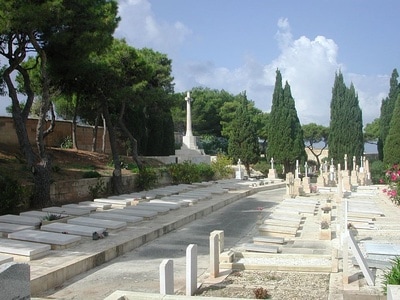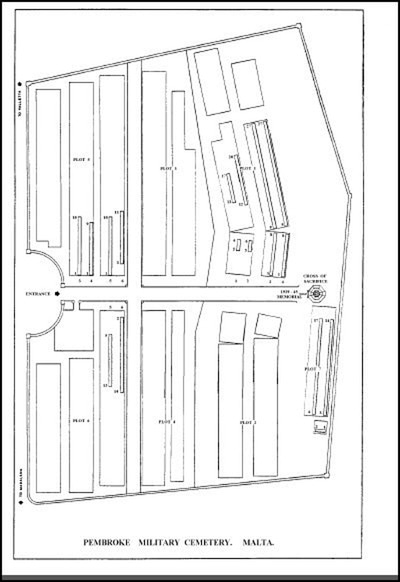PEMBROKE MILITARY CEMETERY AND PEMBROKE MEMORIAL
St. Julian's Bay
Malta
Location Information
Pembroke Military Cemetery is located just off the north-east coastal road that runs from Msida through St. Andrews and to St. Paul's Bay, between St. Andrews and what was formerly St. Patrick's Barracks. It is approximately 3 kilometres away from St. Julian's Bay and about 8 kilometres away from St. Paul's Bay. The rear of the Cemetery is clearly visible from this road. Once approaching St. Andrew's (high ridge) it is clearly sign posted.
Cemetery address: Triq Sir Adrian Dingli, Pembroke.
GPS Co-ordinates: 35.929540, 14.470673
Visiting Information
OPENING TIMES:
December, January and February: Weekdays 7.00am to 4.00pm and Weekends 8.00am to 5.00pm
March, April, May and June: Weekdays 7.00am to 6.00pm and Weekends 8.30am to 6.00pm
July, August and September: Weekdays 6.30am to 7.00pm and Weekends 8.30am to 7.00pm
October: Weekdays 7.00am to 6.00apm and Weekends 8.30am to 6.00pm
November: Weekdays 7.00am to 5.00pm and Weekends 8.30am to 5.00pm
Please note that when the cemetery is unattended, the register and visitor books are kept in the register box near the Cross of Sacrifice.
NOTE: The earth is shallow on Malta and during both wars, many joint or collective burials were made as graves had to be cut into the underlying rock. During the Second World War, such work was particularly hazardous because of air raids. Most of these graves are marked by recumbent markers on which several inscriptions could be carved, and for the sake of uniformity, the same type of marker was used for single graves.
Historical Information
From the spring of 1915, the hospitals and convalescent depots established on the islands of Malta and Gozo dealt with over 135,000 sick and wounded, chiefly from the campaigns in Gallipoli and Salonika, although increased submarine activity in the Mediterranean meant that fewer hospital ships were sent to the island from May 1917.
During the Second World War, Malta's position in the Mediterranean was of enormous Allied strategic importance. Heavily fortified, the island was never invaded, but was subjected to continual bombardment and blockade between Italy's entry into the war in June 1940 and the Axis defeat at El Alamein in November 1942. At the height of Axis attempts to break Malta's resistance in April 1942, the island and her people were awarded the George Cross by King George VI.
Malta's defence relied upon a combined operation in which the contributions made by the three branches of the armed forces and Merchant Navy were equally crucial. Although heavily pressed in defence, offensive raids launched from the island by air and sea had a crippling effect on the Axis lines of communication with North Africa, and played a vital part in the eventual Allied success there.
PEMBROKE MILITARY CEMETERY contains nine Commonwealth burials of the First World War and 315 from the Second World War. The Commission also cares for 273 non-war graves in the cemetery.
Situated within the cemetery is the PEMBROKE MEMORIAL which commemorates 52 servicemen of the Second World War whose graves in other parts of Malta are so situated that permanent maintenance cannot be assured. Their names appear on marble plaques let into the plinth of the Cross of Sacrifice.
Cemetery pictures used with the permission of the Commonwealth War Graves Commission
Pembroke Military Cemetery is located just off the north-east coastal road that runs from Msida through St. Andrews and to St. Paul's Bay, between St. Andrews and what was formerly St. Patrick's Barracks. It is approximately 3 kilometres away from St. Julian's Bay and about 8 kilometres away from St. Paul's Bay. The rear of the Cemetery is clearly visible from this road. Once approaching St. Andrew's (high ridge) it is clearly sign posted.
Cemetery address: Triq Sir Adrian Dingli, Pembroke.
GPS Co-ordinates: 35.929540, 14.470673
Visiting Information
OPENING TIMES:
December, January and February: Weekdays 7.00am to 4.00pm and Weekends 8.00am to 5.00pm
March, April, May and June: Weekdays 7.00am to 6.00pm and Weekends 8.30am to 6.00pm
July, August and September: Weekdays 6.30am to 7.00pm and Weekends 8.30am to 7.00pm
October: Weekdays 7.00am to 6.00apm and Weekends 8.30am to 6.00pm
November: Weekdays 7.00am to 5.00pm and Weekends 8.30am to 5.00pm
Please note that when the cemetery is unattended, the register and visitor books are kept in the register box near the Cross of Sacrifice.
NOTE: The earth is shallow on Malta and during both wars, many joint or collective burials were made as graves had to be cut into the underlying rock. During the Second World War, such work was particularly hazardous because of air raids. Most of these graves are marked by recumbent markers on which several inscriptions could be carved, and for the sake of uniformity, the same type of marker was used for single graves.
Historical Information
From the spring of 1915, the hospitals and convalescent depots established on the islands of Malta and Gozo dealt with over 135,000 sick and wounded, chiefly from the campaigns in Gallipoli and Salonika, although increased submarine activity in the Mediterranean meant that fewer hospital ships were sent to the island from May 1917.
During the Second World War, Malta's position in the Mediterranean was of enormous Allied strategic importance. Heavily fortified, the island was never invaded, but was subjected to continual bombardment and blockade between Italy's entry into the war in June 1940 and the Axis defeat at El Alamein in November 1942. At the height of Axis attempts to break Malta's resistance in April 1942, the island and her people were awarded the George Cross by King George VI.
Malta's defence relied upon a combined operation in which the contributions made by the three branches of the armed forces and Merchant Navy were equally crucial. Although heavily pressed in defence, offensive raids launched from the island by air and sea had a crippling effect on the Axis lines of communication with North Africa, and played a vital part in the eventual Allied success there.
PEMBROKE MILITARY CEMETERY contains nine Commonwealth burials of the First World War and 315 from the Second World War. The Commission also cares for 273 non-war graves in the cemetery.
Situated within the cemetery is the PEMBROKE MEMORIAL which commemorates 52 servicemen of the Second World War whose graves in other parts of Malta are so situated that permanent maintenance cannot be assured. Their names appear on marble plaques let into the plinth of the Cross of Sacrifice.
Cemetery pictures used with the permission of the Commonwealth War Graves Commission

5615850 Private
Henry William James Kite
2nd Bn. Devonshire Regiment
13th June 1940, aged 27.
Coll. grave 1. 4. 4.
Son of Henry James Kite and Rose Ellen Kite, of Weston, Bath, Somerset.
Henry William James Kite
2nd Bn. Devonshire Regiment
13th June 1940, aged 27.
Coll. grave 1. 4. 4.
Son of Henry James Kite and Rose Ellen Kite, of Weston, Bath, Somerset.








